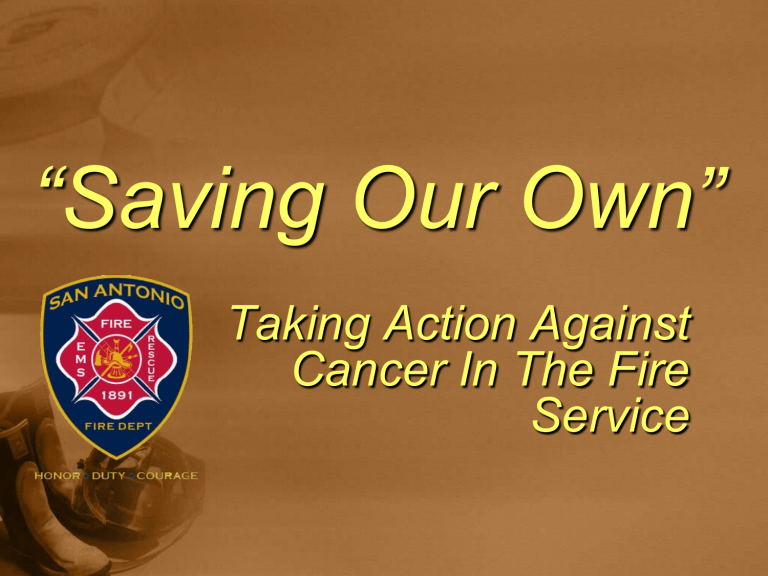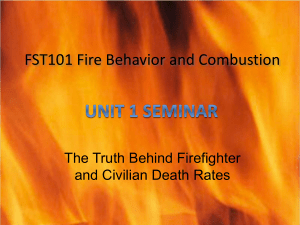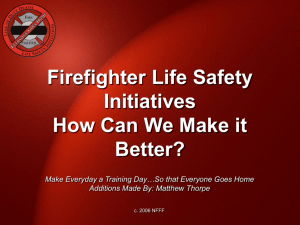Cancer In The Fire Service - San Francisco Firefighters Cancer

“ Saving Our Own ”
Taking Action Against
Cancer In The Fire
Service
Objectives
• Define the scope of the cancer problem in the fire service.
• Discuss the increase in toxic agents in today ’ s fire environment.
• Identify routes of exposure to cancercausing agents.
• Discuss common firefighter exposures to carcinogens.
• Review the steps firefighters can take to protect themselves from cancer.
• Define and discuss Presumptive
Disability Laws.
Scope Of The Cancer Problem
In The Fire Service
•
Cancer is the most dangerous and unrecognized threat to the health and safety of firefighters.
•
Multiple studies have demonstrated the connection between firefighting and cancer.
Scope Of The Cancer Problem In
The Fire Service
(cont.)
“ Pinpointing the exact cause of cancer is extremely difficult because firefighters are not exposed to just one agent. They are exposed to multiple cancer-causing agents.
Because of the multiple exposures and the multiple routes of exposure – they inhale carcinogens and carcinogens are absorbed through the skin – it is also highly unlikely for firefighters to get only one type of cancer.”
- Dr. Grace Le Masters -
Scope Of The Cancer Problem In
The Fire Service
(cont.)
Studies have demonstrated higher rates of multiple types of cancers in firefighters compared to the general
American population including:
•
Testicular cancer (2.02 times greater risk)
• Multiple myeloma (1.53 times greater risk)
• Non-Hodgkin ’ s lymphoma (1.51 times greater risk)
• Skin cancer (1.39 times greater risk)
• Brain cancer (1.31 times greater risk)
•
Malignant melanoma (1.31 times greater risk)
• Prostate cancer (1.28 times greater risk)
• Colon cancer (1.21 times greater risk)
• Leukemia (1.14 times greater risk)
• Breast cancer in women (preliminary study results from the San Francisco Fire Department)
Scope Of The Cancer Problem In
The Fire Service
(cont.)
“ Some cancer studies are also noting that firefighters are developing far more aggressive types of cancers, such as brain cancers, at a younger age than the general population, which provides further indications that the cancer could be a result of firefighting.
”
- Taking Action Against Cancer in the Fire Service white paper -
Scope Of The Cancer Problem In
The Fire Service
(cont.)
36% of the 975 firefighters have been diagnosed with cancer!!!
Scope Of The Cancer Problem In
The Fire Service
(cont.)
Toxicity of Today
’
s Homes
• Today ’ s residential fires have more in common with hazmat events than oldfashioned house fires.
• Contents in homes are made primarily of plastic and synthetic materials.
• Approximately 84,000 chemicals being used commercially today.
• Flame retardants in furniture.
• “ Toxic Hot Seat ”
Toxicity of Other Types of
Fires
• Commercial and vehicle fires have highly concentrated toxic agents.
• Dumpster fires contain completely unknown substances and toxic agents.
Toxicity of Other Types of
Fires
(cont.)
Components of Vehicle Fire Smoke (present during start-up, knockdown, and overhaul):
•
Acrolein - 3
• Methyl methacrylate - 3
• Acrylonitrile – 2B
• Ethyl benzene – 2B
• Toluene diisocyanate – 2B
• Hydrogen Chloride - 3
• Benzene – 1
• 1,3- Butadiene – 1
• Toluene - 3
• Naphthalene – 2B
• Styrene – 2B
• Formaldehyde – 1
Routes of Exposure
•
Two routes of greatest concern for entry of carcinogens into the body of a firefighter are:
• The lungs: When firefighters do not wear or prematurely remove their SCBA – especially during overhaul.
• Dermal Absorption : Carcinogens are absorbed through the skin.
• Inhalation and absorption of toxic substances into the bloodstream.
• Transported and stored in fat cells and organs.
Routes of Exposure
(cont.)
•
Skin is highly absorptive.
Some areas of skin are more permeable than others:
• Face, angle of the jaw, neck, throat and groin.
•
For every 5 ° increase in skin temperature, absorption increases 400%.
Routes of Exposure
(cont.)
• Most permeable piece of PPE is the hood.
• Designed to protect our head and neck from heat.
• Not designed to stop skin absorption through the forehead, angle of the jaw, the neck, and throat.
• Liquid integrity test.
• SAFD firefighters have been issued a 2 nd hood in accordance with the department ’ s
“ Cancer Prevention Initiative.
”
Routes of Exposure
(cont.)
Common Firefighter
Exposures to Carcinogens
•
During the overhaul process
•
Soot particles
•
Diesel engine exhaust
Characterization of Firefighter
Exposures During Fire Overhaul
• Today's synthetic household items pose a risk to firefighters even after a fire is out.
• Materials continue to emit gasses which firefighters continue to breathe.
Characterization of Firefighter
Exposures During Fire Overhaul
(cont.)
Chemicals found during the overhaul phase:
• Formaldehyde - 1
• Asbestos - 1
• Benzene - 1
• Arsenic - 1
• Ethyl benzene – 2B
• Polynuclear aromatic hydrocarbons
(PNAs) - 1*
• Polycyclic Aromatic
Hydrocarbons
(PAHs) - 1*
• Acetaldehyde – 2B
• Styrene – 2B
• Coal-Tar Pitch - 1
• Diesel exhaust - 1
• Vinyl Chloride – 1
• 1,3-Butadiene – 1
Characterization of Firefighter
Exposures During Fire Overhaul
(cont.)
“ Carbon monoxide should not be used as an indicator gas for other contaminants found in the overhaul atmosphere.
”
Characterization of Firefighter Exposures During
Fire Overhaul Study – City of Phoenix
Soot Particles
•
First reported form of occupational cancer attributed to exposure to soot.
•
Prolonged exposure to soot on the skin is a hazard.
• Soot particles absorb hazardous vapors, holding them in place on surfaces including a firefighter ’ s clothing and skin.
Soot Particles
(cont.)
“ A major cause of cancer in firefighters is Polycyclic Aromatic
Hydrocarbons absorbed through the skin as a result of contact with soot, persistently and under hot conditions. The especially high permeability of the groin area results in increased testicular cancer and possibly other types of cancer.
”
- Dr. Stuart Baxter -
Soot Particles
(cont.)
“ People think soot is benign but it is not, and most firefighters coming back from a fire are covered in soot. Soot isn’t just dirty, it ’ s dangerous ”
“ Soot in a firefighters ’ hair or on their skin could leach chemicals into their bodies.
Every smear on their clothes could release toxic gases long after the fire is out.
”
- Dr. Grace Le Masters -
Soot Particles
(cont.)
• If not removed, contaminated exterior surfaces and inner layers of protective clothing and equipment results in exposure well after the incident.
• The neck area is one of the most likely regions to become contaminated.
• Firefighters remove hood and place around neck.
• Demos lead to children being exposed to soot particles.
Diesel Engine Exhaust
• On June 12, 2012, the International
Agency for Research on Cancer (IARC) classified diesel engine exhaust as a
Group 1 carcinogen.
• Exposure is associated with an increased risk of lung cancer.
• Can cause other types of cancer:
• Bladder
• Leukemia and other cancers of the blood (non-Hodgkin ’ s lymphoma and multiple myeloma)
• Vented emissions can disperse up to 650 feet.
Diesel Engine Exhaust
(cont.)
•
Daily exposure to diesel exhaust in the firehouse:
• Walls and furniture reveal a tremendous amount of diesel exhaust particles.
• Diesel particles are inhaled and absorbed every shift and cause significant harm to firefighters.
• Regulators stored in bay.
• Bunker gear stored in bay and taken into the station.
Actions Firefighters Can Take to
Protect Themselves From Cancer
Presumptive Disability Laws
• Links a particular occupation with a disease/condition that has been shown to be a hazard.
• Assumed that it developed in the line of duty.
• Eligible for Worker ’ s Compensation.
• Texas has presumptive disability laws that cover cancer. Covered types of cancer include:
• Lung
• Prostate
• Testicular
• Multiple Myeloma
Presumptive Disability Laws
(cont.)
Texas Government Code
• Sec. 607.055. CANCER. (a) A firefighter or emergency medical technician who suffers from cancer resulting in death or total or partial disability is presumed to have developed the cancer during the course and scope of employment as a firefighter or emergency medical technician if:
• (1) The firefighter or emergency medical technician:
• (A) regularly responded on the scene to calls involving fires or fire fighting; or
• (B) regularly responded to an event involving the documented release of radiation or a known or suspected carcinogen while the person was employed as a firefighter; and
• (2) the cancer is known to be associated with fire fighting or exposure to heat, smoke, radiation, or a known or suspected carcinogen, as described by Subsection (b).
• (b) This section applies only to a type of cancer that may be caused by exposure to heat, smoke, radiation, or a known or suspected carcinogen as determined by the International Agency for Research on Cancer.
Presumptive Disability Laws
(cont.)
Applicability:
• On becoming employed or during employment as a firefighter or emergency medical technician, received a physical examination that failed to reveal evidence of the illness or disease for which benefits or compensation are sought.
• Employed for five or more years as a firefighter.
• Seeks benefits or compensation for a disease or illness covered by this subchapter that is discovered during employment as a firefighter.
Presumptive Disability Laws
(cont.)
A presumption under this subchapter does not apply:
• If the disease or illness for which benefits or compensation is sought is known to be caused by the use of tobacco and:
• (A) the firefighter is or has been a user of tobacco; or
• (B) the firefighter's spouse has, during the marriage, been a user of tobacco that is consumed through smoking.
Presumptive Disability Laws
(cont.)
Presumption Rebuttable:
• A presumption may be rebutted through a showing by a preponderance of the evidence that a risk factor, accident, hazard, or other cause not associated with the individual's service as a firefighter or emergency medical technician caused the individual's disease or illness.
The Decisions You Make…
References
• Taking Action Against Cancer in the Fire Service white paper
• Essentials of Firefighting and Fire Department Operations – 6 th edition
• http://wildfiretoday.com/2008/09/15/cancer-among-seattle-firefighters/
• http://womenfirefighterstudy.com/project-team/
•
The Toxic Hot Seat, HBO
• http://www.seattlepi.com/local/article/Cancer-takes-heavy-toll-on-Seattle-firefighters-
2219169.php#page-3
• http://monographs.iarc.fr/ENG/Classification/
• http://www.firerescue1.com/fire-products/Personal-protective-equipmentppe/articles/1658839-8-ways-to-protect-against-cancer-with-PPE/
• http://www.modernfirefighter.com/cancer-the-unseen-firefighter-killer/
•
Diesel Emissions in Fire Stations; Greg Michalak
• A Study on Chemicals Found in the Overhaul Phase of Structure Fires Using
Advanced Portable Air Monitoring available for Chemical Speciation; Regional
Hazardous Materials Team HM09-Tualatin Valley Fire & Rescue Office of State Fire
Marshal
• Mortality and Cancer Incidence in a Pooled-Cohort of US Firefighters from San
Francisco, Chicago, and Philadelphia (1950-2009); Daniels RD,Kubale TL, Yiin JH.,
NIOSH, National Cancer Institute.
• http://www.firefightercancersupport.org/wpcontent/uploads/2013/06/fighting_fires_fight ing_cancer.pdf
• http://www.iarc.fr/en/media-centre/pr/2012/pdfs/pr213_E.pdf
References
• http://monographs.iarc.fr/ENG/Monographs/vol98/mono98-7.pdf
• Paul Combs, illustrations
• http://www.statutes.legis.state.tx.us/Docs/GV/htm/GV.607.htm
•
SAFD Cancer Prevention Initiative
• http://www.nlc.org/Documents/NLCRISC/NIOSH%20Study%20Analysis%20FINAL%2
011-25-2013%20.pdf
• http://www.huffingtonpost.com/marcia-g-yerman/toxic-hot-seatignitesaw_b_4338572.html
•
Evaluation of Chemical and Particle Exposures During Vehicle Fire Suppression
Training; NIOSH
• Evaluation of Dermal Exposure to Polycyclic Aromatic Hydrocarbons in Firefighters;
USDHHS, CDC, NIOSH
•
Exposure of Firefighters to Diesel Emissions in Fire Stations; Southern Occupational
Health Center and Division of Environmental and Occupational Health Sciences.
• Cancer Incidence Among Firefighters: 45 years of follow-up in five Nordic Countries;
Pukkala E, Martinsen JI, Weiderpass E.
• National League of Cities – Assessing State Firefighter Cancer Presumption Laws and Current Firefighter Cancer Research; TriData Division
• Characterization of Firefighter Exposures During Fire Overhaul; Boldstad-Johnson,
Dawn M., Burgess; Jefferey L., Crutchfield; Clifton D., Storment; Steve, Gerkin,
Richard; Wilson, Jeffrey R.
•
Cancer Risk Among Firefighters: A Review and Meta-analysis of 32 Studies; Grace
K. LeMasters, PhD; Ash M. Genaidy, PhD; Paul Succop, PhD; James Deddens, PhD;
Tarek Sobeih, MD, PhD; Heriberto Barriera-Viruet, PhD; Kari Dunning, PhD; James
Lockey, MD, MS.
References
• https://www.osha.gov/SLTC/dieselexhaust/chemical.html
• http://www.911healthwatch.org/cancer/
• http://www.iafc.org/Operations/LegacyArticleDetail.cfm?ItemNumber=3356
• http://monographs.iarc.fr/ENG/Monographs/vol100F/mono100F-21.pdf
• http://eh.uc.edu/news/pdfs/11-27-2010-Lemasters.pdf
•
Systemic Exposure to PAHs and Benzene in Firefighters Suppressing Controlled
Structure Fires; Kenneth W. Fent, Judith Eisenberg, John Snawder, Deborah
Sammons, Joachim D. Pleil, Matthew A. Stiegel, Charles Mueller, Gavin P. Horn,
James Dalto.
• http://www.iarc.fr/en/media-centre/pr/2007/pr180.html
• http://www.iaff.org/hs/phi/
• http://www.sffdlocal798.org/Vol33no8/Cancer.html
• http://iafcsafety.org/files/2014/10/FCSN-cancer-brief-for-IAFC-e_blast_10.14.pdf
• http://www.firerescue1.com/fire-products/hoods/articles/1677809-How-to-improve-thenext-gen-firefighter-hood/
•
NCCI White Paper on Firefighter Presumptive Coverage
• http://preventionstartshere.org/exposed-chemical-exposures-among-firefighters-topicof-new-study/



